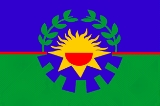
Crucecita
Encyclopedia
Crucecita is a district of the Avellaneda Partido
in Buenos Aires Province
, Argentina
. It forms part of the Greater Buenos Aires
urban agglomeration
.
The town is named for the Arroyo de la Crucecita (Crossing Stream) encountered by a 1580 expedition led by Captain Juan de Garay
, the founder of modern-day Buenos Aires
. The Real Consulado de Buenos Aires ordered a pontoon bridge
built over the stream in 1810, and much of the surrounding land later belonged to the Ximenez family. A wave of immigration in Argentina after 1880 led to the southward expansion of the Buenos Aires metro area part Avellaneda
, and the first lots in Crucecita were sold to homesteaders in 1887. Following the inaugural of a Ferrocarril Provincial de Buenos Aires
station at the site, the Masllorens Brothers factory, a textile maker
, was inaugurated in Crucesita by immigrants from Barcelona
. The Club Social y Deportivo Unión de Crucecita, the local football club, was established in 1939. Presidente Bartolomé Mitre Avenue connects the suburb to Avellaneda, to the north, and Sarandí
, to the south.
Avellaneda Partido
Avellaneda is a partido in Buenos Aires Province, Argentina. It has an area of 55.17 km² and a population of 340,985 . Its capital is the city of Avellaneda....
in Buenos Aires Province
Buenos Aires Province
The Province of Buenos Aires is the largest and most populous province of Argentina. It takes the name from the city of Buenos Aires, which used to be the provincial capital until it was federalized in 1880...
, Argentina
Argentina
Argentina , officially the Argentine Republic , is the second largest country in South America by land area, after Brazil. It is constituted as a federation of 23 provinces and an autonomous city, Buenos Aires...
. It forms part of the Greater Buenos Aires
Greater Buenos Aires
Greater Buenos Aires is the generic denomination to refer to the megalopolis comprising the autonomous city of Buenos Aires and the conurbation around it, over the province of Buenos Aires—namely the adjacent 24 partidos or municipalities—which nonetheless do not constitute a single administrative...
urban agglomeration
Agglomeration
In the study of human settlements, an urban agglomeration is an extended city or town area comprising the built-up area of a central place and any suburbs linked by continuous urban area. In France, INSEE the French Statistical Institute, translate it as "Unité urbaine" which means continuous...
.
The town is named for the Arroyo de la Crucecita (Crossing Stream) encountered by a 1580 expedition led by Captain Juan de Garay
Juan de Garay
Juan de Garay was a Spanish conquistador.Garay was born in Orduña, Spain. He served under the Spanish crown, in the Viceroyalty of Peru...
, the founder of modern-day Buenos Aires
Buenos Aires
Buenos Aires is the capital and largest city of Argentina, and the second-largest metropolitan area in South America, after São Paulo. It is located on the western shore of the estuary of the Río de la Plata, on the southeastern coast of the South American continent...
. The Real Consulado de Buenos Aires ordered a pontoon bridge
Pontoon bridge
A pontoon bridge or floating bridge is a bridge that floats on water and in which barge- or boat-like pontoons support the bridge deck and its dynamic loads. While pontoon bridges are usually temporary structures, some are used for long periods of time...
built over the stream in 1810, and much of the surrounding land later belonged to the Ximenez family. A wave of immigration in Argentina after 1880 led to the southward expansion of the Buenos Aires metro area part Avellaneda
Avellaneda
Avellaneda is a port city in the province of Buenos Aires, Argentina, and the seat of the Avellaneda Partido, whose population was 328,980 as per the ....
, and the first lots in Crucecita were sold to homesteaders in 1887. Following the inaugural of a Ferrocarril Provincial de Buenos Aires
Ferrocarril Provincial de Buenos Aires
The Ferrocarril Provincial de Buenos Aires was a company that operated a 902 km metre gauge railway network in the Province of Buenos Aires in Argentina...
station at the site, the Masllorens Brothers factory, a textile maker
Textile industry
The textile industry is primarily concerned with the production of yarn, and cloth and the subsequent design or manufacture of clothing and their distribution. The raw material may be natural, or synthetic using products of the chemical industry....
, was inaugurated in Crucesita by immigrants from Barcelona
Barcelona
Barcelona is the second largest city in Spain after Madrid, and the capital of Catalonia, with a population of 1,621,537 within its administrative limits on a land area of...
. The Club Social y Deportivo Unión de Crucecita, the local football club, was established in 1939. Presidente Bartolomé Mitre Avenue connects the suburb to Avellaneda, to the north, and Sarandí
Sarandí
Sarandí is a city of the Avellaneda Partido in the Gran Buenos Aires metropolitan area, Argentina. Sarandí is located to the south of the Capital Federal district....
, to the south.

